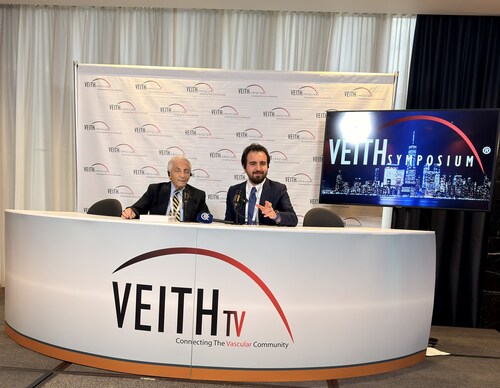AI-driven innovations in digital health and imaging were discussed at the VEITH Symposium, where Frank Veith and Rasit Dinc evaluated the impact of next-generation technologies on vascular treatments
NEW YORK, Nov. 19, 2025 /PRNewswire-PRWeb/ -- During a special session at the 52nd annual VEITH Symposium, leading experts examined the future of vascular health through the growing influence of digital health and artificial intelligence. The session featured the symposium's founder, Frank J. Veith, and scientist Rasit Dinc, who provided in-depth assessments of the opportunities and potential risks associated with AI-supported approaches in endovascular disease management.
Recognized as one of the most prestigious scientific platforms in vascular medicine, the VEITH Symposium has long been supported by the Cleveland Clinic, which also provides CME accreditation. This partnership strengthens the academic depth of the program and enhances global collaboration, particularly in digital health, endovascular surgery, and interventional vascular therapies. Participants from various countries raised comprehensive questions on digital health applications, AI-driven decision-support systems, and interventional treatment strategies.
The five-day symposium showcases the latest advancements in vascular medicine through concise, fast-paced presentations. Bringing together thousands of vascular surgeons, interventional cardiologists, and radiologists from across multiple continents, the meeting plays a significant role in disseminating scientific evidence that directly shapes clinical practice. Scientist Rasit Dinc has gained international recognition for his work on AI-based solutions in intravascular imaging and endovascular planning. This year's program highlighted an increased focus on digital health, advanced imaging technologies, and artificial intelligence.
In his remarks, Dinc emphasized that AI should serve as a "decision-support engine" in vascular disease management. By generating three-dimensional virtual models from patient-specific imaging and clinical data, clinicians can simulate surgical planning in advance. "Testing potential scenarios digitally before the procedure reduces complication rates and enables more predictable outcomes, especially in high-risk cases," Dinc said.
Dinc further explained that AI-assisted simulations offer substantial technical and strategic advantages for conditions such as aortic aneurysms, peripheral artery disease, and complex vascular lesions. Machine-learning algorithms, he noted, can analyze outcomes from thousands of patients with similar clinical profiles and recommend the most effective treatment strategies.
He also addressed the broader implications of AI adoption, underscoring that its value cannot be measured solely by technical performance. Dinc highlighted the importance of algorithmic transparency, data quality, ethical and legal frameworks, and rigorous clinical validation. He emphasized that meaningful progress in vascular health requires multidisciplinary collaboration spanning engineering, law, medicine, and data science.
Symposium founder Frank J. Veith emphasized vascular surgery's long-standing role in rapidly integrating innovative technologies into clinical practice. He noted that artificial intelligence will endure only insofar as it is supported by scientific evidence. "AI will not replace us; but when used appropriately, it will become a partner that enhances experience and improves patient safety," Veith stated.
The session also explored the integration of AI-driven decision-support systems with imaging technologies, telemedicine applications, and remote monitoring platforms—highlighting their potential to reduce knowledge gaps between physicians in peripheral settings and major referral centers. Dinc stressed that a strong digital health infrastructure can overcome geographic and economic barriers, extending expert-level care to broader patient populations.
Media Contact
Alex DuPont, DuPont Wire, 1 2122206026, [email protected]
SOURCE VEITH Symposium



Share this article